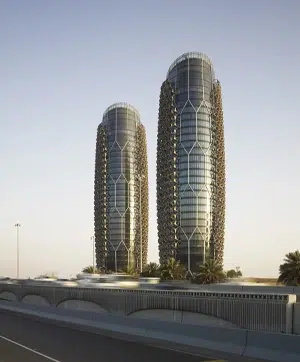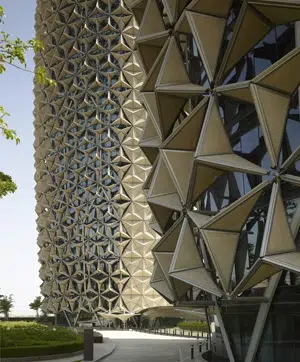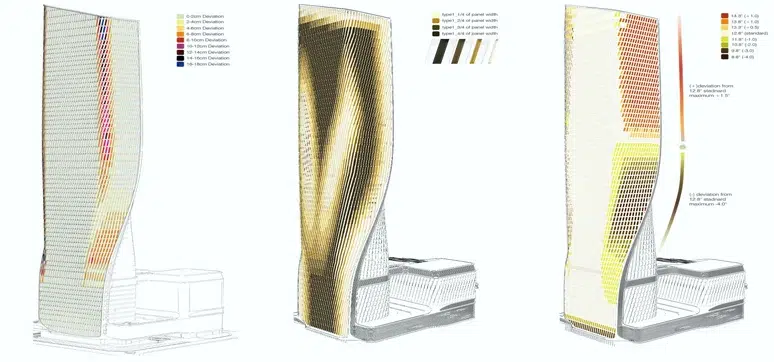How have you seen the adoption of BIM evolve in the field of architecture and façade design over the years?
Over the years, the adoption of Building Information Modeling (BIM) in the field of architecture and façade design has evolved significantly. Initially, BIM was mainly used by larger architecture firms and was more common in infrastructure and complex building projects. However, as technology has advanced and awareness has grown, BIM has become increasingly prevalent across the industry.
In the early stages, BIM was primarily used for 3D visualisation and coordination between different disciplines involved in a project. It helped architects and designers to create digital models and produce more accurate design documentation. BIM evolved to focus on improving collaboration and coordination between architects, engineers, contractors, and other stakeholders. It facilitated the sharing of information, clash detection, and resolving design conflicts before construction, which resulted in a reduction in errors and rework. As BIM platforms matured, architects and façade designers started leveraging the data-rich aspects of BIM models. They began incorporating detailed information about materials, building systems, performance analysis, and sustainability factors. This allowed for better decision-making throughout the design and construction process. BIM has played a crucial role in the adoption and advancement of prefabrication and modular construction techniques. By using BIM, architects and façade designers can create precise digital models that enable off-site manufacturing, leading to improved efficiency, cost savings, and reduced construction time.

BIM software has become more sophisticated, enabling architects and façade designers to perform advanced analysis and simulation. They can assess energy performance, daylighting, thermal comfort, structural integrity, and other factors. This helps optimise the design, enhance performance, and meet sustainability goals. BIM has increasingly integrated with other emerging technologies, such as virtual reality (VR), augmented reality (AR), and Internet of Things (IoT). These integrations have enhanced the visualisation, virtual walkthrough, and maintenance aspects of architecture and façade design.
Overall, the adoption of BIM in architecture and façade design has progressed from basic 3D visualisation to a comprehensive and data-driven approach. Its integration with other technologies continues to drive innovation in the field, improving design quality, collaboration, and project outcomes
In your experience, what are the most significant advantages of using BIM in architectural and façade projects?
Building Information Modeling (BIM) offers several significant advantages in architectural and façade projects. Enhanced Collaboration is a key benefit, as BIM allows all project stakeholders, including architects, engineers, contractors, and clients, to work together in a highly collaborative environment. By using a central 3D model, teams can easily share and coordinate design changes, reducing conflicts and rework. Accurate Design Visualisation is another crucial aspect provided by BIM. It offers 3D visualisation capabilities, enabling stakeholders to visualise the building design and its façades accurately.
This helps ensure design intent is properly communicated and understood by all parties, leading to fewer ambiguities and better decision-making. Clash Detection and Coordination are facilitated through BIM, as it allows for the detection of conflicts between architectural elements and building systems (such as MEP). This helps avoid coordination issues during construction, reducing change orders, delays, and cost overruns. BIM also enables Improved Design Iterations, allowing architects to quickly test and iterate their designs, facilitating better decision-making. By integrating data such as energy analysis and daylight simulation, architects can optimise façade design for energy efficiency and occupant comfort.
Furthermore, BIM offers tools for Quantitative Analysis and Simulation, enabling architects and façade designers to assess the performance of different elements, such as glazing systems, insulation, and shading devices. This helps evaluate thermal performance, daylighting, and energy consumption. Efficient Documentation is simplified through BIM, as it streamlines the creation of accurate construction documentation, including detailed drawings, schedules, and specifications. As changes are made to the 3D model, associated documentation is automatically updated, reducing errors and saving time.
Lastly, BIM data can be leveraged for Enhanced Facilities Management throughout the building’s lifecycle. This information includes maintenance requirements, 3D asset tagging, and equipment details, streamlining operations, and maintenance activities. By embracing BIM and parametric processes for façades, construction professionals can enhance collaboration, streamline workflows, improve efficiency, reduce costs, and create sustainable and visually appealing building envelopes.
By leveraging these advantages, BIM can significantly improve the accuracy, efficiency, and collaboration in architectural and façade projects, leading to better-performing buildings and reduced costs.
What are the benefits of implementing BIM and parametric processes for façades?

Implementing Building Information Modeling (BIM) and parametric processes for façades in the construction industry comes with several benefits. BIM facilitates collaboration by creating a shared digital platform for architects, engineers, contractors, and other stakeholders, ensuring everyone works with the same information and reducing errors. This enhances design visualisation through 3D modeling, allowing stakeholders to view the façade design in detail and make informed decisions. Parametric processes enable testing and evaluating various design options quickly, optimising the façade design. Moreover, BIM and parametric processes streamline design and construction workflows, automatically reflecting changes across all related documentation and saving time. BIM also enables clash detection, identifying conflicts between different building systems early in the design process to mitigate risks and avoid costly rework during construction. Additionally, BIM models provide detailed information about façade elements, materials, and quantities required, leading to more accurate cost estimation and reducing budget overruns. Furthermore, BIM and parametric processes can optimise façade design for energy efficiency and sustainability by simulating and analysing different design variations to assess factors like solar heat gain, daylighting, and thermal performance.
BIM models can be handed over to facility management teams, providing valuable information about façade components, materials, and maintenance schedules, facilitating proactive maintenance planning and reducing downtime. Finally, a parametric approach allows for easy modification and adaptation of façade designs to future changes or renovations, prolonging the building’s lifespan and enabling efficient retrofitting.
By embracing BIM and parametric processes for façades, construction professionals can enhance collaboration, streamline workflows, improve efficiency, reduce costs, and create sustainable and visually appealing building envelopes.
How do you see BIM integrating with other emerging technologies, such as augmented reality (AR) or virtual reality (VR), in the context of architectural and façade design?
Integration of Building Information Modeling (BIM) with emerging technologies like Augmented Reality (AR) and Virtual Reality (VR) can significantly enhance the architectural and façade design process. Through AR, professionals can superimpose digital models onto the physical world, enabling real-time visualisations of how a design will blend with its surroundings. VR, on the other hand, creates fully immersive 3D environments that enable stakeholders to experience the design as if they were physically present. BIM combined with AR and VR can facilitate real-time collaboration among project stakeholders, allowing them to experience and interact with the model simultaneously from different locations. For example, architects can gather feedback and input from clients using VR, allowing them to experience the design and provide more accurate feedback.
Additionally, AR and VR can help validate design decisions by simulating real-world scenarios, such as testing the building’s performance metrics, sunlight exposure, acoustics, and more. This real-time feedback can help refine design elements, ensuring optimal efficiency and performance of the final product. On construction sites, AR can overlay BIM models onto the physical space, allowing contractors to view the models in the context of the actual site and facilitating accurate and efficient construction. AR can also assist in identifying clashes or conflicts between building components early on, reducing rework and delays.
Moreover, BIM integrated with AR can support facility managers by providing real-time information about building systems and components. AR overlays relevant data onto physical elements, enabling technicians to quickly identify and address maintenance issues, thus streamlining operations and enhancing the overall lifecycle management of the building.
In summary, the integration of BIM with emerging technologies like AR and VR offers numerous benefits to architectural and façade design. It enhances visualisation, collaboration, decision-making, validation, on-site construction, and facility management, leading to improved efficiency, accuracy, and sustainability throughout the project lifecycle.
What challenges do you believe still exist in the widespread adoption of BIM in the architecture and façade industry?
Building Information Modeling (BIM) has been transformative for the architecture, engineering, construction, and operation (AECO) industries, including the niche area of façade design and construction. However, several challenges can affect its widespread adoption. Initially, there are significant initial investment and training costs associated with adopting BIM technology. This requirement encompasses expenses for software, hardware, and training, which can pose a barrier for small firms or those in emerging markets with limited budgets. Moreover, BIM is complex and demands a substantial amount of user training, constituting a steep learning curve, especially for professionals accustomed to traditional drafting methods. Another challenge is the interoperability issues that arise with BIM models needing to function seamlessly across different software platforms. This need is particularly pronounced in the façade industry, where professionals often collaborate with stakeholders employing various BIM software, resulting in compatibility issues. Furthermore, there exists a lack of standardisation in BIM across the industry. Different companies and regions may adhere to distinct standards, complicating efforts to maintain consistency in BIM practices.
Resistance to change is also prevalent among some industry practitioners who may be reluctant to adopt new technologies due to their comfort with existing processes or skepticism about the benefits of BIM. Additionally, the management of vast amounts of data generated by BIM poses a challenge, especially regarding data accuracy, security, and management throughout a building’s lifecycle. Legal and contractual issues require updating to reflect the collaborative nature of BIM, with complexities surrounding intellectual property rights, responsibilities, and risk allocation. Moreover, there is a lack of awareness or understanding about the benefits of BIM in certain sectors of the industry, which may impede its adoption. The façade industry is highly specialised and fragmented, with different components sometimes developed independently, hindering the seamless adoption of BIM processes.
Corporate cultures that do not foster innovation and collaboration can experience reduced effectiveness in BIM adoption, as the tool heavily relies on collaborative approaches. Additionally, BIM software may have limitations in handling the detailed complexities of façade systems or may not be optimised for the unique requirements of façade engineering. On large or highly complex projects, managing the BIM process can become unwieldy, necessitating advanced coordination and management skills.
Despite these challenges, the benefits of BIM, including enhanced collaboration, higher quality designs, improved efficiencies, and better building performance, are driving its increased adoption across the industry. Solutions to these challenges are actively being sought through improved software capabilities, better data standards, and ongoing education within the industry.
How can BIM contribute to sustainable design practices, particularly in the context of façade materials and energy efficiency?
Building Information Modeling (BIM) can contribute significantly to sustainable design practices, especially concerning façade materials and energy efficiency. BIM enables designers to evaluate different façade materials in terms of their environmental impact, such as embodied energy, carbon emissions, and life cycle assessment. By simulating various materials within the BIM model, designers can make informed decisions and select sustainable options that enhance energy efficiency. Additionally, BIM software can integrate energy analysis tools to simulate the building’s energy performance. Designers can assess how different façade materials affect energy consumption, daylighting, and thermal comfort. This information helps optimise the design to achieve higher energy efficiency and reduce the building’s carbon footprint. Moreover, BIM allows designers to analyse how different façade materials impact natural light penetration and distribution. By simulating daylighting effects, designers can optimise the façade design to maximise natural light, reduce reliance on artificial lighting, and minimise energy consumption. Furthermore, BIM can simulate the building’s thermal behavior by considering factors such as insulation, solar gain, and air leakage through the façade. By analysing how different materials respond to external conditions, designers can optimise the façade design to enhance thermal comfort and reduce the need for excessive heating or cooling, thereby improving energy efficiency.

Lastly, BIM promotes collaboration among project stakeholders, including architects, engineers, contractors, and suppliers. By using a coordinated BIM model, teams can work together to identify opportunities for sustainable design measures in the façade system, including the use of renewable materials, increased insulation, or integration of renewable energy technologies. Overall, BIM provides a platform for better visualisation, analysis, and decision-making throughout the design process, enabling architects and engineers to adopt sustainable practices and optimise energy efficiency in façades.
Are there any emerging trends or technologies in BIM that you believe will significantly impact the future of architecture and façade design?
Building Information Modeling (BIM) is an intelligent 3D model-based process that provides architecture, engineering, and construction (AEC) professionals the insight and tools to more efficiently plan, design, construct, and manage buildings and infrastructure. With technology constantly advancing, BIM is at the forefront of many emerging trends and technologies that have the potential to significantly impact the future of architecture and façade design.
Building Information Modeling (BIM) is continuously evolving, with several emerging trends and technologies that promise to significantly impact the future of architecture and façade design. Generative Design, for instance, utilises AI algorithms to create optimised building designs based on parameters such as energy efficiency, material usage, and spatial relationships. This approach can lead to innovative façade designs that are both aesthetically pleasing and high-performing. Augmented Reality (AR) and Virtual Reality (VR) technologies are allowing architects and designers to visualise BIM models in new ways, facilitating immersive walkthroughs and enabling stakeholders to better understand façade designs before construction.
Integration of IoT with BIM enables real-time monitoring of building performance, with sensors providing data on factors such as energy performance, structural health, and environmental impact, leading to more responsive and adaptive façade systems. Digital Twins, digital replicas of physical assets, processes, or systems, can aid in lifecycle management of buildings, providing a detailed representation to analyse efficiency and identify areas for improvement in façade design and operation. Advanced Materials and Smart Façades, including phase-changing materials and biomimetic façades, offer new possibilities for design and functionality, making buildings more energy-efficient and their exteriors more dynamic. Prefabrication and Modular Construction, facilitated by BIM, allow for faster construction times, lower costs, and higher precision in the assembly of complex façade elements. Sustainable Design and Green Building are promoted through BIM by analysing façade options in the context of local climate data and integrating renewable energy sources, such as solar panels, into designs. 3D Printing enables the creation of intricate and custom façade shapes that are difficult or impossible to produce with traditional methods. Data Analytics and Machine Learning leverage BIM-generated data to predict performance, identify trends, and propose optimisations for improved environmental and energy performance in façade design.
Collaboration Platforms, such as cloud-based BIM collaboration platforms, enhance team coordination and integration of façade designs with other building systems, ensuring alignment among stakeholders regardless of location. It is important to note that while these trends and technologies offer exciting prospects for the future of architecture and façade design, the pace of their adoption varies depending on factors such as industry readiness, regulatory environment, and economic considerations. As these technologies mature and integrate further with BIM processes, the impact on architecture and façade design will likely be substantial, leading to smarter, more efficient, and more aesthetically innovative buildings. Professionals in the field need to stay up-to-date with these advances to remain competitive and deliver the best value in their projects.
How technology can be used to reduce costs, reduce defects, and improve designs?
Technology plays a pivotal role in reducing costs, reducing defects, and improving designs within the construction and real estate industries. Building Information Modeling (BIM) technology allows for the creation of accurate virtual models of buildings, which can be used for planning, design, construction, and management. BIM helps in detecting clashes and design issues early, thereby reducing defects and the need for expensive rework. It also enhances collaboration among all stakeholders. Predictive Analytics, through advanced data analytics, can forecast future trends and behaviors by analysing past performance and data patterns. This can lead to cost savings by optimising operations, maintenance, and energy consumption, and it can be used to improve the design by predicting how a building and its systems will perform before they’re built. Automation and Robotics within construction can significantly reduce labor costs and increase production rates while reducing human error that can lead to defects. Robotics can be used in automation-heavy tasks like bricklaying, concrete dispensing, and even complex tasks like plumbing and electrical work in some scenarios.
Virtual Reality (VR) can assist in visualising and experiencing the design before the start of construction, helping to improve the architectural design and make informed decisions. Augmented Reality (AR) can be used to overlay design models over physical spaces to ensure the design and construction are adhering closely to specifications. 3D Printing in construction allows for rapid prototyping and production of complex building components at a fraction of the traditional time and cost. It can also reduce waste material and enable designs that are not possible with traditional construction techniques. Drones can be utilised for site inspections, surveying, and progress monitoring. They reduce the time and cost associated with such tasks and improve the accuracy of data collected, which can inform better design adjustments.
Artificial Intelligence (AI) can optimise design elements for performance and cost, suggest improvements, and even automate some design tasks. Machine learning algorithms can process vast amounts of data to find patterns and solutions not easily visible to human designers. Internet of Things (IoT) sensors can be embedded into buildings to monitor structural health, energy usage, and operational efficiency. The data from these sensors can be used to improve the design of future projects and reduce operating costs while ensuring that buildings remain safe and efficient. Materials Innovation, including new and innovative materials, can result in cost savings, reduction in defects, and improved designs. Smart materials, responsive surfaces, and sustainable composites are being explored for use in the real estate industry. Cloud-based Collaboration Tools allow for seamless communication and data sharing among all parties involved in a project. In doing so, they can reduce time delays, avoid misunderstandings, and thus save costs and reduce design errors.
Technology implementation in these areas requires an initial investment, but the payoff typically outweighs the costs through enhanced efficiency, reduced errors, and innovative design solutions that are both aesthetic and functional.
What are the requirements and differences in BIM and parametric procedures?
Building Information Modeling (BIM) & parametric design are two distinct, although related, processes often used in the architecture, engineering, and construction (AEC) industry.
Building Information Modeling (BIM):
BIM is a digital representation of the physical and functional characteristics of a facility. It is a process that involves the generation and management of digital representations of places being constructed. BIM is used for planning, design, construction, operation, and maintenance of buildings and infrastructure.
The requirements for BIM are essentially about collaboration and information management:
- Software Tools: Appropriate BIM software (such as Revit, ArchiCAD, Bentley Systems, etc.) is required to create and manage BIM models.
- Standard Protocols: Standard protocols and formats (e.g., IFC, COBie) for data sharing and interoperability between different BIM tools and stakeholders.
- Training: Team members need to have adequate training in BIM tools, processes, and best practices.
- Information Sharing: Centralised information storage and sharing mechanisms for various stakeholders to access and update the model.
- BIM Execution Plan (BEP): This document outlines the roles and responsibilities, BIM goals, workflows, and information exchanges for the project.
- Level of Development (LOD): Different levels of development specify the detail and accuracy of BIM elements at various stages in the design and construction process.
Parametric Design:
Parametric design is a process based on algorithmic thinking that enables the expression of parameters and rules that define, encode, and clarify the relationship between design intent and design response. In parametric design, some requirements include:
- Parametric Modeling Tools: Software that supports parametric design such as Grasshopper for Rhino, Dynamo for Revit, or other parametric design and computational tools.
- Algorithmic Thinking: Understanding the creation and manipulation of parametric rules, relationships, and algorithms.
- Coding/Scripting Knowledge: Knowledge of a programming or scripting language may be beneficial for creating complex parametric models.
- Performance Analysis: Often, parametric design is linked with performance analysis where optimised design solutions are sought based on certain criteria or constraints.
- Flexible Approach: Adaptability to changes since parametric designs can evolve significantly with changes in input parameters.
Differences between BIM and Parametric Design:
- Focus: BIM focuses on the management of building data throughout its lifecycle, while parametric design focuses on the generation of complex geometries and structures based on set parameters and rules.
- Flexibility: Parametric design gives designers the ability to explore a wide range of design options quickly, as a change to a parameter updates the entire design instantly. BIM is more about maintaining accurate data that reflects the designed, constructed, and operational state of the building.
- End-use: BIM models are used for documentation, construction, collaboration, and facility management. Parametric models may be used in the early design phase to assess many iterations efficiently, impacting the design process but not necessarily the management of the built asset.
- Core Purpose: The core purpose of BIM is information management, while parametric design’s core purpose is about exploring and optimising complex designs.
In many modern projects, BIM and parametric design workflows are integrated, where the parametrically designed components are incorporated into BIM for a more comprehensive approach to the design, construction, and management of buildings and infrastructure.
How 3D parametric modelling and automation can help meet customer demands?
3D parametric modeling and automation can greatly enhance the ability to meet customer demands in several ways. Firstly, customisation becomes more efficient with 3D parametric modeling, allowing for the creation of highly detailed and accurate digital models that can be easily tailored to meet specific customer requirements. The parametric nature of the models facilitates quick and efficient changes, enabling a faster response to customer requests. Additionally, 3D parametric models provide a realistic and immersive visual representation of a product or space, aiding customers in better understanding and visualising the end product. This reduces misunderstandings and enhances communication, as customers can provide feedback and adjust based on the visual representation, enabling more accurate customisation. Moreover, the ability to quickly modify and update 3D parametric models allows designers to rapidly iterate and test various design options, aligning them more effectively with customer demands. This iterative process helps refine the final design to meet the customer’s vision and requirements. Furthermore, automation integrated into the 3D parametric modeling workflow automates repetitive tasks and increases productivity, streamlining processes. This frees up time for designers to focus on meeting customer demands and providing tailored solutions while reducing the chances of errors and inconsistencies, ensuring higher accuracy and reliability in delivering customer requirements. Ultimately, by utilising 3D parametric modeling and automation, the design and production process can be streamlined, leading to cost and time savings. Customisation can be achieved more efficiently, reducing the need for rework or starting from scratch, resulting in a faster turnaround and improved customer satisfaction.
Overall, leveraging 3D parametric modeling and automation empowers design teams to efficiently respond to and meet customer demands while ensuring accuracy, customisation, and cost-effectiveness.
Why does BIM appear to be fundamental in the current architectural design? How can architects use BIM to streamline complex façade designs?
BIM (Building Information Modeling) is fundamental in the current architectural design for several reasons. It allows architects, engineers, contractors, and other stakeholders to collaborate on a single digital platform, enhancing communication, coordination, and integration of design elements. This collaborative approach leads to more efficient project workflows. Additionally, BIM provides detailed 3D models that enhance visualisation, enabling architects to assess different design options and make informed decisions. It also facilitates analysis such as energy performance, structural integrity, and clash detection, minimising errors and improving the overall quality of the design. Moreover, BIM helps architects streamline the design process, reduce rework, and improve efficiency. It facilitates accurate quantity takeoffs, cost estimation, and construction sequencing, aiding in the optimisation of resources and schedules.
When it comes to complex façade designs, architects can utilise BIM to streamline the process in several ways. Firstly, architects can create accurate 3D models of complex façades, incorporating all relevant elements such as curtain walls, glazing, cladding, sunshades, and ventilation systems. This allows for a comprehensive understanding of the design and facilitates better decision-making. Furthermore, BIM tools enable architects to assess the performance of the façade design, including factors like thermal efficiency, daylighting, solar gain, and wind resistance. By simulating how the façade will interact with its environment, architects can optimise the design for energy efficiency and occupant comfort. Additionally, BIM software can detect clashes between the façade elements and other building systems like structure, MEP (mechanical, electrical, and plumbing), or interior elements. This early clash detection minimises rework and coordination issues, saving time and cost during construction. Lastly, BIM allows for the generation of detailed construction documentation, including various views, sections, and schedules specific to the façade design. This improves communication with contractors, fabricators, and installers by providing precise information and reducing ambiguity.
Overall, BIM enhances architects’ ability to design, analyse, and coordinate complex façade systems, resulting in more efficient and successful projects.
Conclusion
Architectural visualization and design have undergone significant advancements thanks to the emergence of Building Information Modelling (BIM) software. This innovative tool has completely reshaped how architects, engineers, and designers approach the conceptualization, creation, and communication of their ideas within the architecture and construction realms. With its sophisticated features and capabilities, BIM software has evolved into a crucial instrument in this industry landscape. This article aims to delve into the multifaceted aspects of BIM software and unravel its profound significance in architectural visualization and design.
One of the fundamental strengths of BIM software lies in its ability to amalgamate all pertinent information into a singular digital model. This functionality empowers architects to envision the building in three-dimensional space and explore a myriad of design permutations. The software facilitates seamless modifications to the model, providing architects with real-time insights into how alterations impact other elements. This level of adaptability and interactivity profoundly enriches the design process, enabling architects to make well-informed decisions grounded in precise data.
Furthermore, BIM software facilitates effortless sharing of virtual models among team members, fostering a harmonious environment for collaborative efforts. Engineers can conduct rigorous analyses to ascertain the structural integrity of the design, while contractors can meticulously estimate costs and devise meticulous construction schedules. Clients also benefit from this technological marvel by visualizing the building in its entirety and offering constructive feedback, thereby ensuring that their expectations align seamlessly with the final outcome.
In summation, the integration of BIM software has become indispensable in the realm of architectural visualization and design. Its comprehensive suite of features, collaborative prowess, and cutting-edge visualization techniques have fundamentally altered how architects conceptualize and articulate their ideas. Leveraging BIM software empowers architects to streamline the design process, augment stakeholder engagement, and craft sustainable and aesthetically captivating architectural masterpieces. Embracing BIM software signifies a transformative paradigm shift in the architecture and construction domain, empowering professionals to achieve superior project outcomes and deliver exceptional built environments that resonate with both functionality and visual allure.














